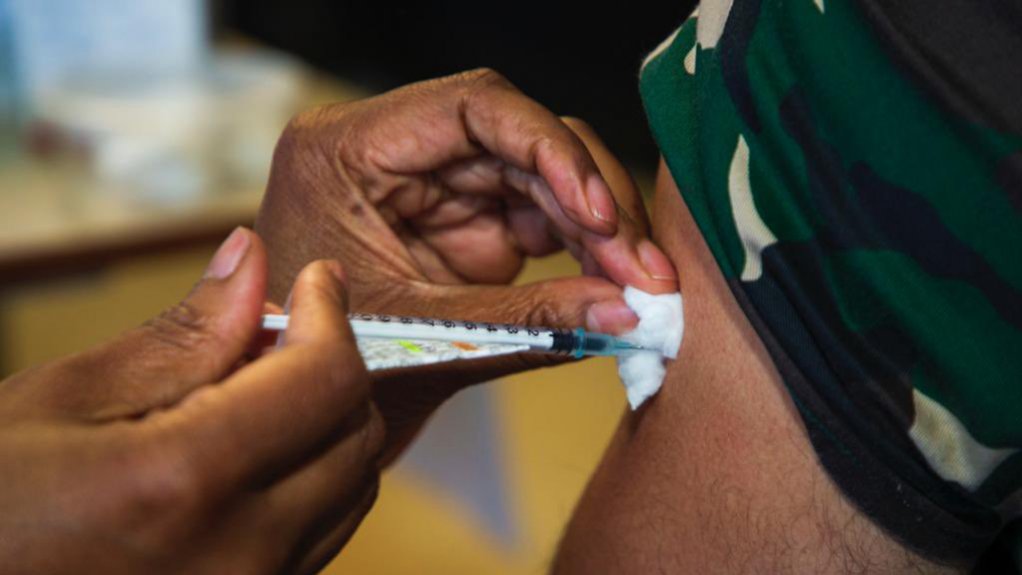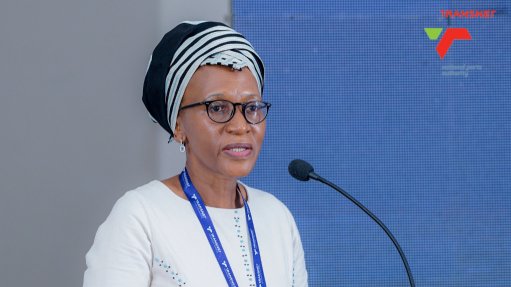Business outlines strategy for supporting ramp-up to daily vaccination tempo of 250 000 by September
Business for South Africa (B4SA) has outlined its strategy for a steady upscaling of the private sector’s capacity to administer the Covid-19 vaccine and position the country’s public and private health sectors to reach a daily vaccination rate of more than 250 000 by September.
B4SA health working group chair Stavros Nicolau acknowledged on Friday that public scepticism persisted over the ability of South Africa to raise its daily vaccination tempo to between the 250 000 and 300 000 being targeted during Phase 2 of the roll-out, through which government aims to vaccinate 16.6-million people between May and November.
Part of this scepticism has arisen as a result of the slow pace of Phase 1, which aims to vaccinate 1.2-million healthcare workers.
However, Nicolau stressed that the pace of vaccinations under Phase 1 had been constrained largely because it was implemented under stringent trial conditions, which resulted in an average daily rate of between only 2 000 and 3 000. At its peak, 13 000 healthcare workers were vaccinated in a single day.
Phase 1 was governed by the Sisonke vaccine research trial of the Johnson & Johnson (J&J) vaccine, initiated to vaccinate health workers after the AstraZeneca vaccine, initially procured for the purpose, was found to be ineffective against mild cases of the variant of Covid-19 first found in South Africa and which had emerged as the dominant variant in the country by early 2021.
Ahead of government placing a temporary halt on the administering of the J&J vaccine, after the US Food and Drug Administration and the Centers for Disease Control and Prevention paused the vaccine’s use in America so as to further investigate the relationship between the vaccine and the development of extremely rare blood clots, South Africa had vaccinated 291 000 health workers.
“With over 53 000 deaths caused by Covid-19 in our own country over the last 13 months, B4SA believes that vaccines remain the safest and most effective instrument we have in combating the virus,” Nicolau argued.
This view was supported forcefully by Professor Barry Jacobson, president of the Southern African Society of Thrombosis and Haemostasis, who called for an immediate resumption of the J&J roll-out, owing to the extremely low risk of blood clots being caused by the vaccine.
“To put it into perspective, your risk of being struck by lightning is in the region of one in 500 000, while your risk of developing this particular form of clotting is in the region of one in a million. So, you theoretically have to be struck by lightning twice to equate to the risk of getting this very rare cause of thrombosis,” Jacobson said, noting Covid-19 was itself a “huge cause of thrombosis”.
The pace of the Phase 1 roll-out had also been affected by the lack of doses, with South Africa having been late off the mark in securing sufficient stocks in a context of aggressive competition for vaccines globally.
Government has intensified its procurement efforts since the start of the year, however, and has announced that it has secured 62-million doses; 31-million of the J&J single-dose vaccine, 30-million of the double-dose Pfizer vaccine and a further one-million from the multilateral Covax facility.
Nicolau reported that 5.6-million Pfizer doses and 3-million J&J doses would be available in South Africa during the second quarter, which would enable the public vaccination roll-out, starting with citizens over the age of 60, to begin in May. It would also enable all 1.2-million health workers to be vaccinated ahead of a third wave that was expected to coincide with the country’s winter season.
A further 8.6-million Pfizer doses, 9.1-million J&J doses, as well as 5.3-million more doses from the African Union platform would be available in the third quarter.
During Phase 2, some five-million people over 60 years of age will be prioritised initially, but the programme will be expanded, in time, to those under 60 with comorbidities (some 8-million people), essential workers (about 2.5-million), and persons living in congregate settings (some 1.1-million).
Phase 3, under which government aims to vaccinate 22.6-million additional adult South Africans falling outside of the Phase 1 and 2 designations, is expected to begin in November.
On April 16, the Department of Health’s Electronic Vaccination Data System (EVDS) was officially opened to receive registrations by people over 60 years of age in addition to health workers, a development which B4SA described as momentous.
The EVDS is a Web-based portal that has reportedly been stress tested to handle thousands of simultaneous registrations a second and has geo-spatial intelligence to match those who register with their nearest vaccination point.
Nicolau expressed confidence that, given the “unprecedented” cooperation currently between the public and private sectors on the vaccination roll-out, the programme could be scaled up to meet the country’s vaccination targets over the coming nine to 12 months.
He stressed that South Africa was no stranger to mass vaccinations, administering some 14-million vaccines, mostly paediatric, yearly, as well as about 1.3-million flu shots every year in a four- to six-week period.
B4SA’s Dr Guni Goolab said that to enable a ramp-up to a daily tempo of 250 000 vaccinations by September the number of public and private vaccination sites would need to rise from 17 under the Sisonke trial to thousands of sites.
These additional vaccination points would include:
- health sites, such as pharmacies, hospitals, and general practitioners;
- sector or employer sites, such as mines, corporate facilities, government and parastatal sites where occupational health infrastructure and services already existed, as well as congregate settings, such as care homes; and
- ten mass vaccinations sites to be set up in the eight metropolitan areas.
As more and more sites were accredited from May through to September, the vaccination capacity would rise progressively to a peak of 250 000 a day by September, which would have to be sustained and expanded during Phase 3.
Employer sites were seen as key to the scale-up and Dr Lungi Nyathi said rules had been created for establishing such sites, which should have captive populations – including workers, their families and surrounding communities – of between 5 000 and 10 000 people, so that they could perform at least 200 vaccinations a day.
This minimum site scale was based on the size of the Pfizer pack, which comprises 1 170 doses and could be kept for only five days once thawed. Prior to thawing, the Pfizer vaccine needed to be stored at ultra-low temperatures of about -70 °C.
B4SA steering committee chairperson Martin Kingston said business was aware that the opening of the EVDS registration process to people over 60 was only the beginning of a massive national effort.
“Not everything will be smooth sailing as we are building and improving this capacity as we go, but we are committed to addressing any issues quickly and collaboratively. Everyone will need to play their part. We are confident that we can defeat this once-in-a-century health crisis and reach our national goal of 40-million vaccinations by February 2022.”
Article Enquiry
Email Article
Save Article
Feedback
To advertise email advertising@creamermedia.co.za or click here
Comments
Announcements
What's On
Subscribe to improve your user experience...
Option 1 (equivalent of R125 a month):
Receive a weekly copy of Creamer Media's Engineering News & Mining Weekly magazine
(print copy for those in South Africa and e-magazine for those outside of South Africa)
Receive daily email newsletters
Access to full search results
Access archive of magazine back copies
Access to Projects in Progress
Access to ONE Research Report of your choice in PDF format
Option 2 (equivalent of R375 a month):
All benefits from Option 1
PLUS
Access to Creamer Media's Research Channel Africa for ALL Research Reports, in PDF format, on various industrial and mining sectors
including Electricity; Water; Energy Transition; Hydrogen; Roads, Rail and Ports; Coal; Gold; Platinum; Battery Metals; etc.
Already a subscriber?
Forgotten your password?
Receive weekly copy of Creamer Media's Engineering News & Mining Weekly magazine (print copy for those in South Africa and e-magazine for those outside of South Africa)
➕
Recieve daily email newsletters
➕
Access to full search results
➕
Access archive of magazine back copies
➕
Access to Projects in Progress
➕
Access to ONE Research Report of your choice in PDF format
RESEARCH CHANNEL AFRICA
R4500 (equivalent of R375 a month)
SUBSCRIBEAll benefits from Option 1
➕
Access to Creamer Media's Research Channel Africa for ALL Research Reports on various industrial and mining sectors, in PDF format, including on:
Electricity
➕
Water
➕
Energy Transition
➕
Hydrogen
➕
Roads, Rail and Ports
➕
Coal
➕
Gold
➕
Platinum
➕
Battery Metals
➕
etc.
Receive all benefits from Option 1 or Option 2 delivered to numerous people at your company
➕
Multiple User names and Passwords for simultaneous log-ins
➕
Intranet integration access to all in your organisation




















